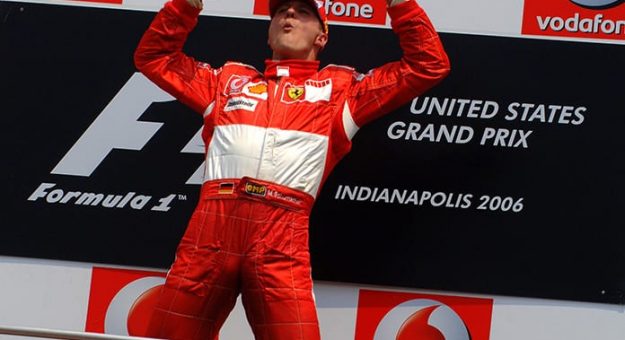INDIANAPOLIS – The driver arguably considered the greatest Formula One racer of all time, at least by the numbers, and a man whose voice spread the word of the Indianapolis 500 to all continents on the Earth, can now be called Hall of Famers.
Seven-time Formula One champion Michael Schumacher and broadcaster Paul Page have been voted into the Indianapolis Motor Speedway Hall of Fame. They will be inducted into the Hall of Fame along with the 2020 class that includes the driver many believe to be the greatest NASCAR racer of all time, Dale Earnhardt. Also, racing pioneer Janet Guthrie, the first female ever to race in the Indianapolis 500, will be inducted.
Earnhardt and Guthrie were named to the Hall of Fame last year, but the induction ceremony was carried over to this year because of the ongoing COVID-19 pandemic.
Both classes will be honored at the 2021 IMS Hall of Fame Induction Ceremony and Indianapolis 500 Oldtimers Dinner presented by Firestone on Thursday, May 27 at the Downtown Indianapolis Marriott.
Schumacher and Page were elected to the IMS Hall of Fame by the voting panel of 150 motorsports journalists, officials and living Hall of Fame members, chosen from a total of 14 nominees representing the Speedway’s diverse history as host to the Indianapolis 500, Brickyard 400 and, from 2000-2007, F-1’s United States Grand Prix at Indianapolis.
Schumacher ranks as one of the world’s all-time greatest driving talents, having earned a record-seven F-1 championships and holding F-1 records in nearly every driver-related category during his career.
Schumacher became the first German to win the F-1 title in 1994, capturing eight wins with the Benetton team throughout the 16-race championship season. He repeated as champion in 1995 with Benetton, then moved to Ferrari for the start of 1996 and an era that would produce one of the most dominant driver-team combinations in motorsports.
After battling for the championship to the season finale in 1996, ’97 and ’98, Schumacher and Ferrari finished fifth in points in 1999 and then won five consecutive titles from 2000-04. The only other driver in F1 history to earn seven driver championships is Lewis Hamilton, who accomplished the milestone in 2020 driving for Mercedes.
It was also during the 2000s that Schumacher won five of the eight United States Grands Prix contested at Indianapolis Motor Speedway, including the inaugural race in 2000 and four in a row from 2003-06. Schumacher finished second at the United States Grand Prix in 2001-02 and earned four pole positions at Indianapolis.
Schumacher retired at the end of the 2006 season but announced a return with the Mercedes team for 2010. He drove three seasons for Mercedes, earning his 155th and final career podium at the 2012 Grand Prix of Europe at Valencia, Spain, and a total of 91 F-1 victories.
Sadly, in December 2013 the champion driver sustained head injuries while skiing with his family in the French Alps. Schumacher fell and, despite wearing a helmet, suffered severe head injuries. He continues to recover from the accident at his home in Switzerland.
In May 2020, Formula One announced that Schumacher was named the most influential person in the sport’s 70-year history, based on fan voting.
Page’s voice is known to motorsports enthusiasts around the world. The Evansville, Ind., native served as The Voice of the 500, or chief announcer, on the Indianapolis Motor Speedway Radio Network for 13 years, and as television host and play-by-play voice for Indianapolis 500 coverage on ABC Sports an additional 16 years.
Page started his career in Indianapolis radio and joined WIBC-AM, the flagship station for the IMS Radio Network, in 1968. Page found a mentor in the legendary Sid Collins, Voice of the 500 from 1952-76. Page joined the network’s Indianapolis 500 coverage team in 1974, and in the wake of Collins’ death in early May 1977, Page took over the chief announcer position and held it until 1987.
After a one-year stint as play-by-play announcer for NBC Sports’ coverage of the CART series, plus NASCAR, Formula 1 and NHRA drag racing, Page moved to ABC Sports’ Indianapolis 500 broadcast team in 1988.
He anchored what was one of the most entertaining booths in motorsports broadcast history, sharing it with former drivers Bobby Unser and Sam Posey.
Page covered a variety of events for ABC and ESPN until 2012, including INDYCAR racing, CART and NHRA drag racing coverage – even the annual Nathan’s Hot Dog Eating Contest.
He returned to the IMS Radio Network as Voice of the 500 in 2014-15 and co-hosted the broadcast of the 100th Indianapolis 500 in 2016 with Mark Jaynes, who took over as the voice in 2017 and remains the chief announcer.
The Indianapolis Motor Speedway Hall of Fame honors and celebrates the contributions and achievements of an exclusive group of individuals at the Indianapolis Motor Speedway, encompassing was founded in 1952 as the Auto Racing Hall of Fame under the auspices of the Contest Board of the American Automobile Association (AAA). The Hall of Fame was moved to the original Indianapolis Motor Speedway Museum under the direction of then-Speedway president Anton “Tony” Hulman Jr. in 1962.
The Indianapolis Motor Speedway Museum is home to one of the world’s premier motorsports and automobile collections, with interpretive emphasis on the Indianapolis 500 and its role as an American icon of sporting tradition and innovation.
Located inside the famed 2.5-mile Indianapolis Motor Speedway oval, the Museum is open 363 days a year (closed Thanksgiving and Christmas). It is a nonprofit 501(c)(3) organization which relies on support from admissions, tours, sponsorships, annual memberships and planned-giving for its operations, educational programming, restoration and preservation efforts, and special exhibits and events.
